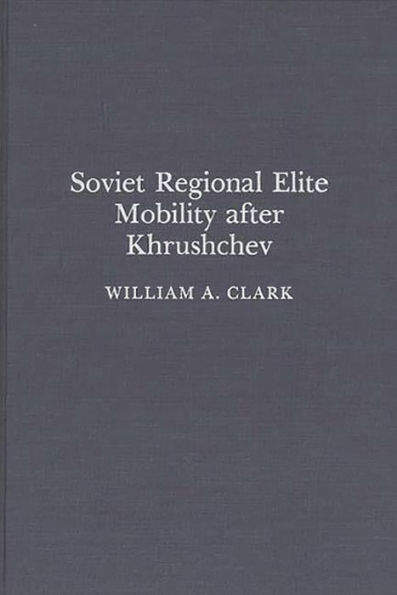5
1


Hardcover(New Edition)
$95.00
-
PICK UP IN STORECheck Availability at Nearby Stores
Available within 2 business hours
Related collections and offers
95.0
In Stock
Overview
Clark's groundbreaking study covers the period in Soviet political history from the fall of Nikita Khrushchev in late 1964 through the spring of 1987 and examines the forces affecting regional elite mobility throughout the Soviet Union during these years. Turbaning the explanatory focus away from the traditional areas of patronage and clientelism, Clark adopts a novel approach to the subject by concentrating on structural variables such as the economic, social, and demographic aspects of the regions themselves as key elements of an explanation for long-term mobility trends. In addition to his focus on non-traditional variables, the broad chronological scope of the study and the fact that all Soviet republics with equivalent party structures are examined make Clark's work especially valuable for graduate students and scholars of Soviet politics and government seeking a more general and inclusive explanation of regional elite mobility than has been available in previous studies of the subject.
The study is based on an exhaustive examination of the careers of over 275 Obkom (regional party committees) First Secretaries. As a result of this analysis, the 129 regional party structures of the USSR are ranked hierarchically with respect to political mobility. Throughout the study, Clark seeks to isolate non-idiosyncratic variables to explain the significant variance in mobility opportunities offered by the various regional party units. Thus, rather than relying on the traditional personalistic variables, Clark seeks to identify independent variables that have explanatory value throughout the Soviet system. Finally, Clark examines the effects of background characteristics and functional career types on elite mobility at the Obkom tier, and analyzes changes in regional cadres policy after Brezhnev. Six appendices provide additional information for the student and researcher.
The study is based on an exhaustive examination of the careers of over 275 Obkom (regional party committees) First Secretaries. As a result of this analysis, the 129 regional party structures of the USSR are ranked hierarchically with respect to political mobility. Throughout the study, Clark seeks to isolate non-idiosyncratic variables to explain the significant variance in mobility opportunities offered by the various regional party units. Thus, rather than relying on the traditional personalistic variables, Clark seeks to identify independent variables that have explanatory value throughout the Soviet system. Finally, Clark examines the effects of background characteristics and functional career types on elite mobility at the Obkom tier, and analyzes changes in regional cadres policy after Brezhnev. Six appendices provide additional information for the student and researcher.

Product Details
| ISBN-13: | 9780275931247 |
|---|---|
| Publisher: | Bloomsbury Academic |
| Publication date: | 07/21/1989 |
| Series: | Contributions to the Study of Childhood |
| Edition description: | New Edition |
| Pages: | 217 |
| Product dimensions: | 6.14(w) x 9.21(h) x 0.56(d) |
About the Author
WILLIAM A. CLARK is Associate Director of the James F. Byrnes International Center and teaches in the Department of Government and International Studies at the University of South Carolina. Clark has published in the areas of regional elite mobility and Soviet leadership transition. His current research activity relates to the impact of subnational actors in Soviet politics.
Table of Contents
PrefaceIntroduction: The Concept of Political Elite Mobility in the Soviet System
Obkom First Secretaries, Political Mobility, and "Seilschaften"
Toward the Construction of a Political Mobility Ranking of Oblast Communist Party Committees
Soviet Regional Elite Mobility: The Search for Non-Idiosyncratic Independent Variables
Elite Mobility at the Obkom Tier: The Effects of Background Characteristics and Functional Career Types
Regional Cadres Policy after Brezhnev: Changes in the Obkom Elite
Summary and Conclusions
Appendix I: Stewart's Positions, Codes, and Mobility Index
Appendix II: Positions and Codes as Scored on Mobility Index
Appendix III: Selected Data on Regional Units of the Soviet Union
Appendix IV: Rotated Factor Scores for Oblast Developmental Variables
Appendix V: Career Types of Obkom First Secretaries: A Codebook
Appendix VI: Changes in Obkom First Secretaries in the Post-Brezhnev Period
Bibliography
Index
From the B&N Reads Blog
Page 1 of
